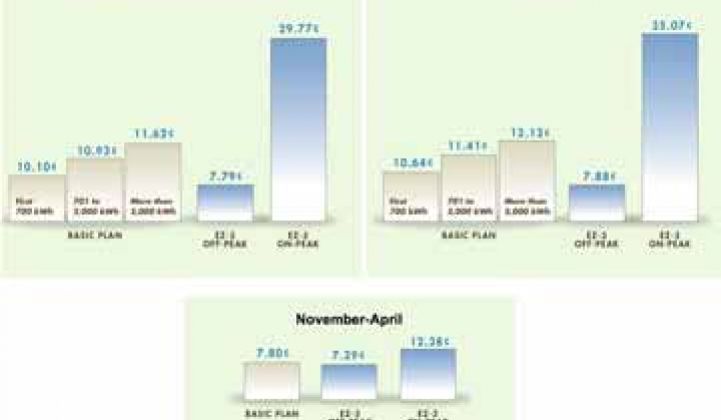Recent pilots have found that switching residential customers from flat rates to variable pricing schemes is not as scary as it sounds. People don’t storm the utility and protest, and in many cases, consumers save money and electricity.
Pilots, however, are not always analogous to how things will play out in the real world. Many pilots include a bevy of technology, including smart meters and in-home displays that would make a full rollout extremely expensive. Two live programs, far beyond the pilot stage, have found that bells and whistles aren’t necessary to move people on to time-of-use pricing plans.
Toronto Hydro was mandated to move its customers to TOU pricing, and the results have been mixed. Across the continent, Arizona’s Salt River Project Agricultural Improvement and Power District has had voluntary TOU options for years, and it continues to grow and expand. Adjusting prices will surely not be a one-size-fits-all process, and successful pilots in one region may not reveal what can be accomplished in very different climates and political environments. But these two utilities are showing that moving onto variable pricing is possible, if not without some growing pains.
When you talk to Toronto Hydro or SRP, the first words you hear are “trust” and “customer benefits,” in regards to their approach. Without careful customer education, an easily navigable website and a trained call center, changing price plans will be excruciating for everyone involved. “Regardless of the price structure, we needed a billing system that was accurate,” said Blair Peberdy, Vice President at Toronto Hydro. From there, they beefed up their website for people to compare current rates to the new rates before the changes went into effect. And just before the launch, every single person in the call center was trained not only on the rates but on the rationale behind the program.
It all sounds rosy, and calls to the utility only went up about 10 percent after the changes, but the rates set by the Ontario Energy Board “aren’t exactly consumer-friendly,” said Peberdy. It’s not because they’re too high -- rather, the changes aren’t shocking enough to change behavior. “The overall reaction has been relatively neutral,” he said.
The rates vary from about $0.04 to $0.09 per kWh between peak and off-peak. After about a year of TOU prices, 40 percent of customers saw a decrease during summertime, but other homes saw an increase. During winter, when there are two peak times, during both morning and evening rush hours, about 80 percent saw higher bills. But even with increases, over the entire year, the average bill only went up about $1.50 per month.
“We think there should be a more simplified rate structure in our opinion, with two price periods and no summer/winter differences,” said Peberdy. However, it’s not up to the utility, although they are hoping to convince the regulators in May or November of this year to make a change.
Some of the problems stem from Toronto’s low electricity prices due to large amounts of hydropower. The other issue is that their summers aren’t as hot as New York City, let alone Arizona, and winter heating is based on natural gas. But even though the gains in terms of shaving peak might not be as big as other regions, the utility thinks it can get greater gains from TOU programs. Ideally, it would like to see one peak period from about 2 p.m. to 8 p.m. on weekdays, only with prices of about $0.05 off peak and around $0.11 on peak.
The utility does have a 300-megawatt peak load reduction by 2014, but it doesn’t see much, if any, of that coming from the residential sector. Demand response programs are only being pushed on the commercial side. It’s not looking to do residential DR right now, and it’s also not looking to put in smart thermostats or in-home displays, mostly because of the cost.
Instead, the focus remains on making it easier to do business with the utility as it tweaks its TOU program. “That and simplified rates will, I think, set the platform for a more sophisticated relationship that will be more technology-based,” said Peberdy. “We need to break through on the ease of doing business.”
SRP is also all about serving its customers. As the third-largest public power utility in the U.S., SRP has had a variable pricing plan available for years to offer more options to its residential customers. Unsurprisingly, it’s called the time-of-use plan.
Let’s stop here and talk about SRP’s website. It is one of the easiest utility websites to navigate that this reporter has ever had the pleasure of clicking through, and I’ve seen a lot. There are no bells or whistles. Pages provide just the right information without being overloaded. It is simple to find information about what is offered to the residential customers, and the best part is that it’s written in language I can understand: “Find out more; Are you on the right pricing plan?”
For customers, there is a webpage where they can track their daily usage and sign up for alerts when they cross set spending points or kWhs. Nearly 20 percent, or about 195,000 customers are using the TOU plan. There are three “seasons”: July/August, November to April and all other months. In May through October, peak is considered 1 p.m. to 8 p.m. and, like Toronto Hydro, winter peaks are in both morning and night from 5 to 9.
Off peak for all times is about $0.065, and this only rises to about $0.102 in winter, but can climb to $0.213 in the high heat of summer and $0.19 per kWh in spring and fall. “We’ve focused on effective pricing that would benefit the customer in the form of savings and benefit SRP in the form of price signals,” said Michael Mendonca, Manager of Revenue Cycle Services at SRP. Unlike Toronto, the various seasons and different price signals don’t seem to deter customers. In fact, customers see an average 6 percent to 7 percent reduction in annual bills.
There is also a relatively new variable pricing plan that falls somewhere between the basic plan and the TOU plan. SRP’s EZ-3 has one peak period: 3 p.m. to 6 p.m. year-round. Off peak is somewhere around $0.075 all of the time but peak spikes up to $0.35 per kWh in July and August. Spring and fall are still nearly $0.30 but it drops to $0.12 in winter. In less than a year, about 30,000 people have signed up. Those customers are seeing roughly a 5 percent reduction in annual bills, but are saving as much as 25 percent during peak times.
In case two TOU plans weren’t enough, SRP also has the largest prepaid program in the U.S., with about 112,000 customers enrolled. Those consumers tend to reduce their energy use by about 12 percent. Currently, you can’t be enrolled in both a prepaid program and a TOU program, but Mendonca said that option will be available in coming years.
SRP seems to prove that simple is not always better when it comes to price points -- instead, transparency and choice might trump simplicity. “Our focus even on the highest level is on customer satisfaction,” said Mendonca. Arizona is not Toronto, however, and perhaps the relatively mild temperatures in Canada would be better suited to a more basic TOU plan.
While both SRP and Toronto are putting in smart meters (SRP’s EZ-3 requires a smart meter), there is little other technology, besides a website, and neither utility is aggressively looking to bring other products to their customers.
Another option that you don’t see in either of these two utilities that you see in various pilots is rebates on peak savings. For some areas that solution might be the answer, but Toronto and SRP have found that proper education and access to daily usage data is enough to move customers into variable pricing plans. Also, from SRP’s prepaid program to Toronto Hydro’s Winter Warmth Program, both utilities have an active focus on low-income customers to make sure that even basic pricing structures do not leave certain people without essential services.
Creativity, customer care and flexibility have been critical to allow both Toronto Hydro and SRP to move into having all or large parts of their customer base (no one once used the rather clinical term 'rate-payer') on to TOU. For Toronto, the mandate is only the beginning of finding the right mix of rates that will benefit both users and the utility. At SRP, the increase in options is part of its mandate to have happy customers -- happy customers who might pay up to $0.30 for electricity when it’s swelteringly hot outside. It’s possible and it’s already happening.
Research Spotlight

Time-of-Use Without the Technology
Two utilities show that to get variable pricing to work, all your customers need is a little education and a well-designed website.

Time-of-Use Without the Technology
-
41Where Will DOE’s Loan Program Make the Next Climate Tech Investments?
-
15What the Frack Is Happening With Natural Gas Prices?
-
9With an Energy Crisis Brewing, No Peak in Sight for Emissions


